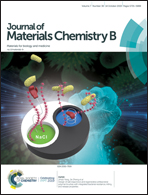Low fouling and ultrasensitive electrochemical immunosensors with dual assay methods based on Fe3O4 magnetic nanoparticles†
Abstract
Low fouling electrochemical immunosensors with both “signal-off” and “signal-on” analytical methods were developed for the highly sensitive and efficient detection of cancer antigen 15-3 (CA 15-3) in human serum samples. The antifouling sensing interfaces were constructed by assembling multifunctional polyethylene glycol on gold electrodes, followed by covalent conjugation with CA 15-3 antibody. Pure antigens and Fe3O4@Ag will competitively bind to the immobilized antibody on the electrode. Fe3O4 magnetic nanoparticles attached to the working electrode and collected by a magnetic electrode were treated via electrochemical conversion to generate electroactive Prussian blue as a signal readout. Therefore, these two signals measured independently were complementary, and this design allowed one to choose the assay method according to real situations so as to ensure accuracy of the immunosensor. Moreover, owing to its good antifouling property, the immunosensor was capable of detecting CA 15-3 even in complex human serum samples, demonstrating potential application in quantitative analysis of real patient serum samples.



 Please wait while we load your content...
Please wait while we load your content...